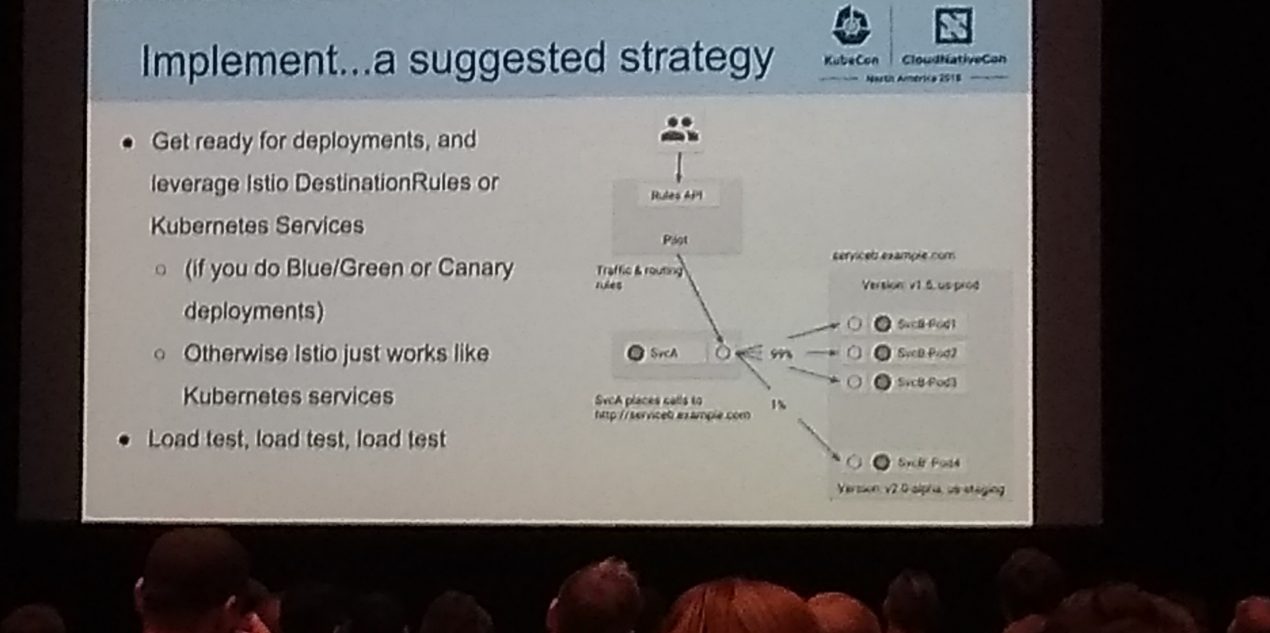As we wrap up this year’s KubeCon, Braden finishes up his experience by starting his day started with Keynote: Smooth Operator♪: Large Scale Automated Storage with Kubernetes – Celina Ward, Software Engineer & Matt Schallert, Site Reliability Engineer, Uber.
“It was a little weird to have two back to back keynotes talking about operators (previous keynote: Kubernetes: Living Up to the Hype – Janet Kuo, Software Engineer, Google),” says Braden. “But, M3DB was a good case study of how moving to K8s and using operators helped. None of this was new info to me except M3DB.”
There were comparisons to large-scale Prometheus installs like Cortex or Thanos, which are based on Prometheus and have large communities and integrate easily with K8s.
“If it was a talk on M3DB vs Prometheus options I would have been more interested,” Braden continues. ”But, considering its a keynote, it was fine.”
Keynote: Kubernetes and the Path to Serverless – Kelsey Hightower, Staff Developer Advocate, Google
“Kelsey is an excellent and polished presenter. Combined with the fact he usually talks about interesting topics.” Braden mentions, “It was a really interesting talk about serverless in K8s“.
Starting with a PoC of running, Fortran in K8s. Once he got it running he explained why serverless was a good fit here. He took the binaries he was running in K8s and was able to run them in a Lambda. It didn’t get into Knative or Fission for Serverless in K8s which I’m really interested in. but, there are talks on that later today. Serverless in K8s is really intriguing to me. Especially, with vast about of Events in K8s to trigger off of.
In regards to dev wanting to run code about launching shuttle… let me teach you K8s “space can wait,” Kelsey says in his keynote.
Getting at the point that K8s lets devs focus on the problem they are solving. It’s not about teaching everyone all the ins and outs of K8s, and all the cloud tools. It about letting them solve the problem; in his example: getting to space and back.
“What’s modern? Most people are just throwing json around the wire. If that’s modern, I don’t want that.” Kelsey says.
Docker is great for composing at build time, but hard to compose at run-time; which is one use for serverless.
Braden decided to break his rules of not going to beginner talks, he slipped into the keynote: Understanding Microservices with Distributed Tracing – Lita Cho, Lyft.
“Which was fine for a beginners talk. Beginners would probably get a lot out of it.” Braden mentions.
There was an interesting tidbit about how they had links to traces as dots in a grafana dashboard.
“I’d be interested in learning more about that, and the talk also mentioned that with Envoy you can get zero touch tracing but just glazed over the fact that you won’t get as much detail because it’s not language specific. If you decorated your code you can start to get more insight into how long individual function takes to run, etc. that I have not been able to find with zero-touch tracing Envoy gives you, its simply not language aware.” Braden says.
Panel Discussion: Ask Us Anything: Microservices and Service Mesh – Moderated by Jason McGee, IBM
“I got very little out of this. But, to be fair they asked who in the room was NOT familiar with Service Meshes and about half of the room raised their hands,” says Braden. “So it ended up being a lot lower level than I was hoping. They had one person for Linkerd and a few who use/work on Istio. I was hoping it would be more on the level of the Deep Dive on Envoy.”
One interesting tidbit is that you can add arbitrary envoy code in Istio, so, if Istio hasn’t exposed an Envoy feature you want, you can still use it. There was a little talk about ASync being harder in Service Meshes because of the unknown involved makes it harder to setup security rules. This is an inherent issue with Service Meshes and not an Istio or Linkerd issue. They also mentioned when you roll out a Service Mesh for the next six months it will be blamed for all issues. Even though it’s more often DNS.
There was some discussion on API gateway vs service mesh. API gateways are normally on the edge but they need same functionality internally for services.
“Reminded me of idea of NGFW and fact that you really want them inline for service to service communication and not just edge traffic,” Braden mentions. “That they don’t really see a distinct bt the 2. I never liked the term API gateway and they mentioned it’s essentially just a L7 proxy/edge router.”
Click the button below to get started!
